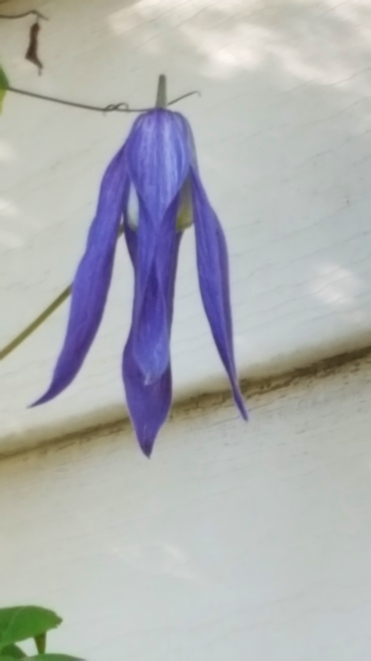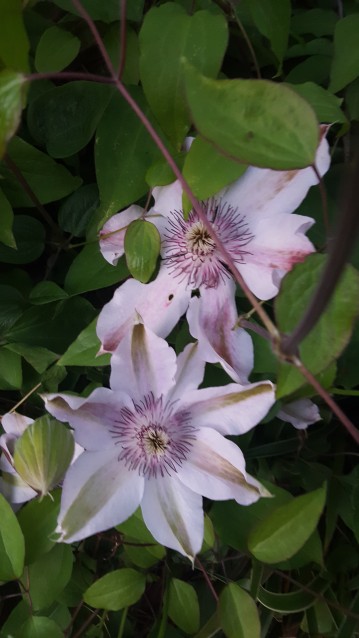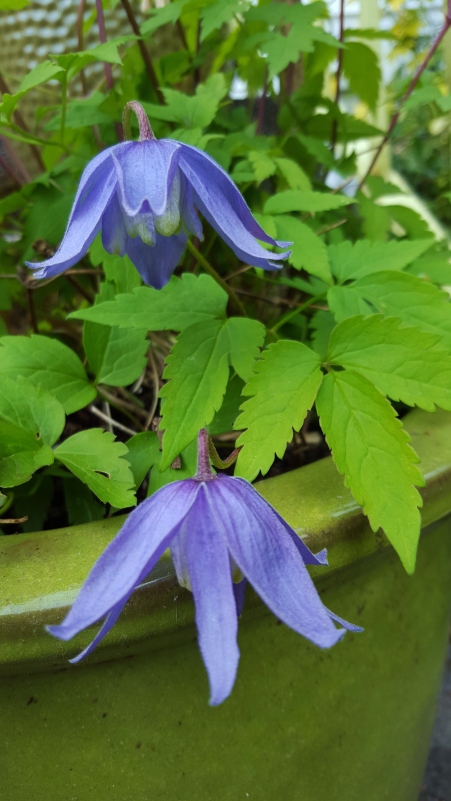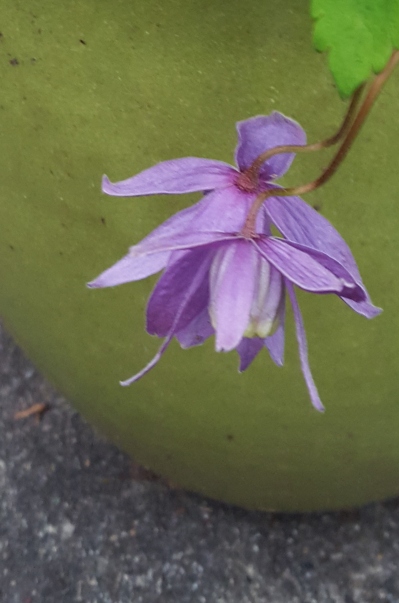
Clematis viorna in early August, blooming away.
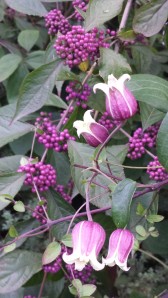
C. viorna still blooming in October with beauty berry.
August was a difficult month for clematis in Seattle, where we suffered the hottest summer on record, along with very little rain. OK, OK, so some people loved it — but not me or my clems. I’m learning the hard way that most clematis do NOT like really hot dry weather. Many of mine took a snit and slowed down or stopped flowering altogether, AND developed crispy brown or spotted leaves. Hrmph, not an alluring effect.
But Clematis viorna came through the hot weather like a charm, perhaps because it originates from the summer-hot southeastern US. This clematis, which began blooming for me in late May or June, continued to sport loads of blossoms and unscathed leaves throughout the month of August, making it my garden’s Clematis of the Month for August.

Purple leaves of C. recta purpurea for the second time.

C. recta purpura, blooming a second time in late August!
The Challenger
Clematis recta purpurea was a contender this month, even though it was Clematis of the Month for July. This clematis, which has the most beautiful rich purple foliage in the spring, bloomed wonderfully in June with small fragrant white flowers. As noted last month, I cut it back to the ground when it finished blooming and quickly got new purple leaves, as expected. But I did not expect it to bloom again! Check out it’s second blooming in August!
Problem Clematis
In June and July, I cut back several clematis–hard–for various reasons. Clematis Vancouver Morning Mist wilted in June for the FOURTH year in a row. I cut it back to the ground and informed the culprit that my patience was gone. In the fall, it would be OUTA HERE! One August morning, I noticed something pink beckoning me over by the entry path. Good gracious! It was C. Vancouver Morning Mist opening the first of what turned out to be seven blossoms. I must have scared the living daylights out of it! I guess I’ll keep it.

C. Vancouver Morning Mist — Reprieve!
I was loosing my patience with C. Duchess of Edinburgh, too. This clematis had one woody stem with no flowers and scorched ugly leaves. Yuch! I couldn’t take it. Even though I might seriously set it back, I chopped it to about six inches. It’s in a pot with a great-looking, heat-loving Chilean Glory Vine (probably a little crowded in there), so I didn’t miss the clematis much. Well, to my surprise, C. Duchess of Edinburgh came back FAST with big fresh new leaves — and a bit later with several big fat buds! The blooms were not double as they are in the spring, but they were lovely large pristine white blooms that looked great with all the greenery. I wonder if clematis leaves grown in the cool moist spring and early summer in Seattle just aren’t programed to take our hot dry summers. In my experience (especially this summer) leaves that come into being in the heat of summer handle hot and dry just fine.

The Duchess Blooms!
As mentioned in an earlier post, my young Clematis Tartu (with lovely large ruffled lilac blossoms in spring) succumbed to the wilt just as the first flower bud was ready to open and had to be whacked back to the ground. Very disappointing, especially since I had it in a new ceramic pot by the patio! But like C. Vancouver Morning Mist, this one grew back quickly and actually had several blooms in August. Check it out!

C. Tartu blooms without wilting!
What these three clematis have taught me is that if a clematis wilts, has scorched leaves, or is looking just plain ugly, go ahead and cut it back! It may well come back and bloom again in the same year. Some of my clematarian friends (like Debbie Fisher of Silver Star Vinery and Linda Beutler of the Rogerson Clematis Collection) have tried to tell me for years to cut them back at the drop of a hat, but I guess I just needed to see it for myself.
A Few More August Blooms

C. Beauty of Worcester blooming in August instead of spring!

Clematis Freckles blooming in August instead of October!

C. Kermisina blooming as expected–in August.

C. crispa

Dainty C. Little Nell (named for the young neighbor of the hybridizer)

C. Princess Red
